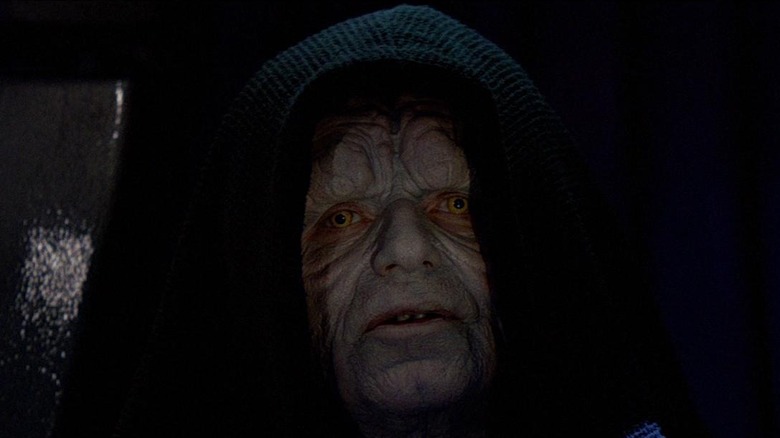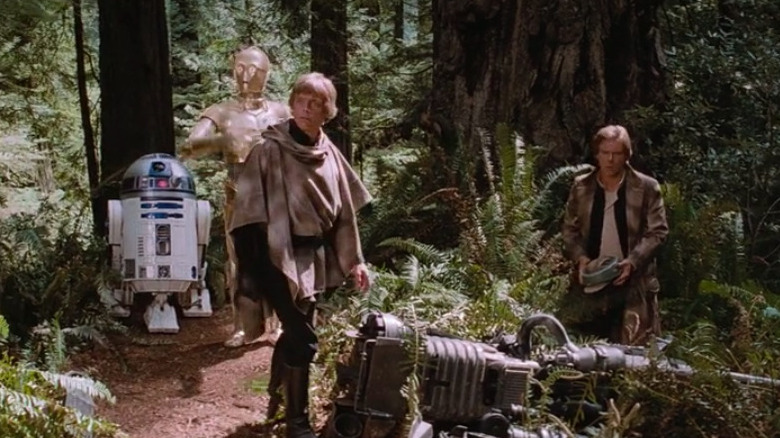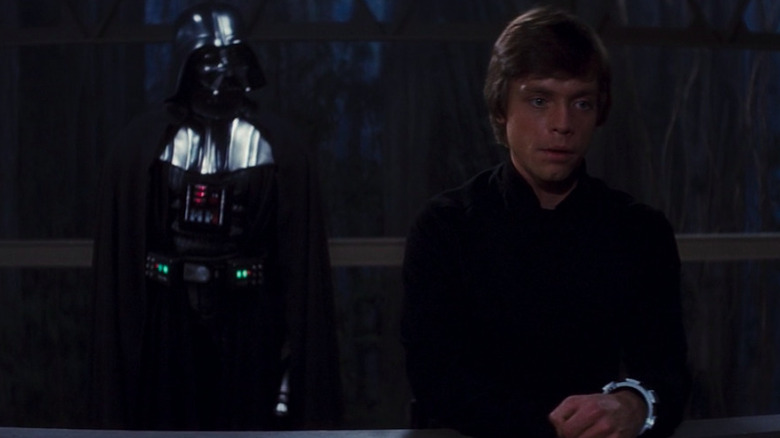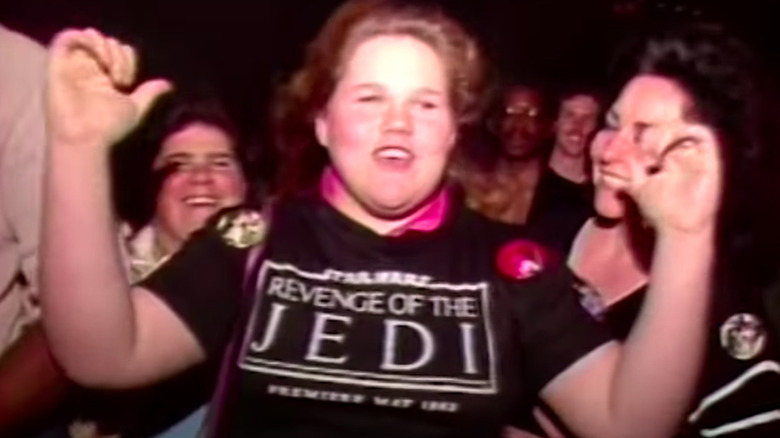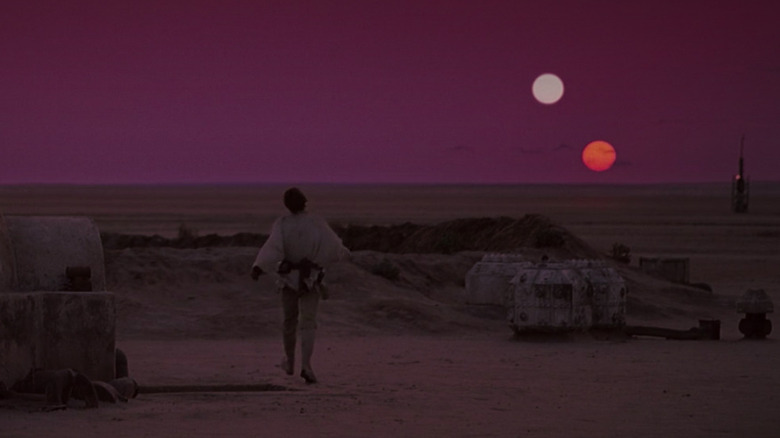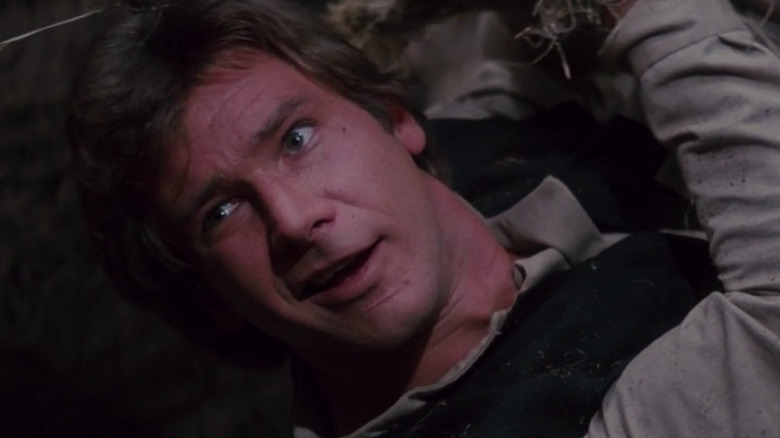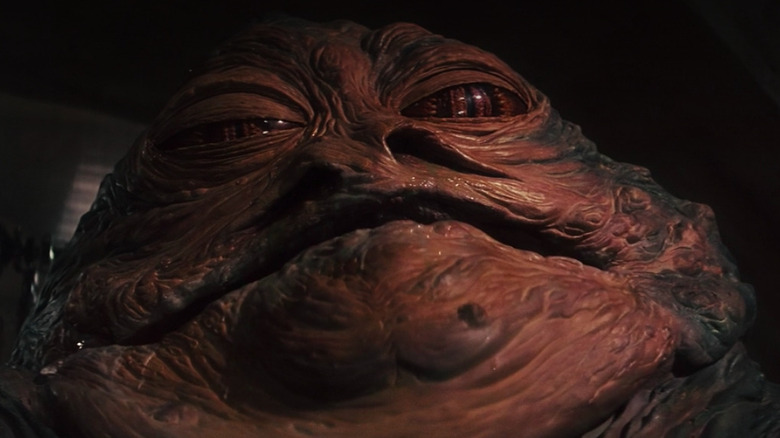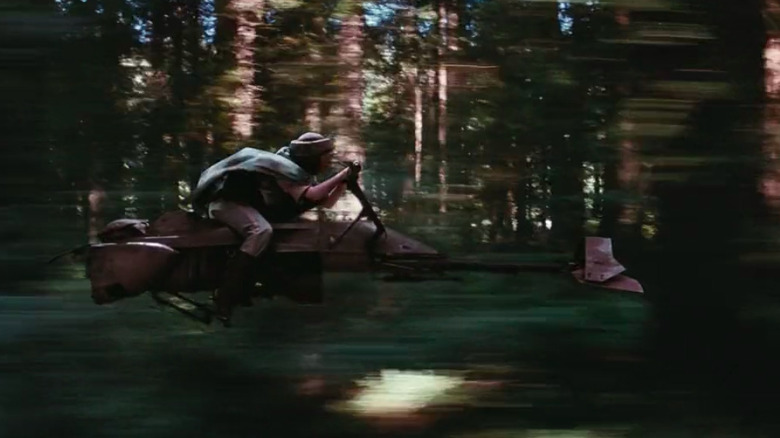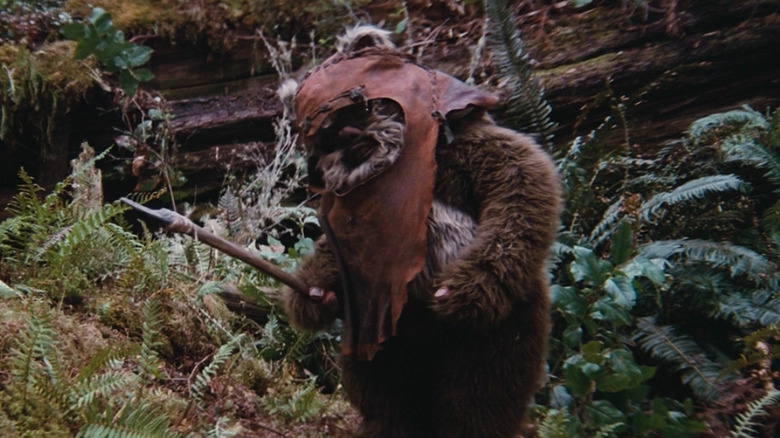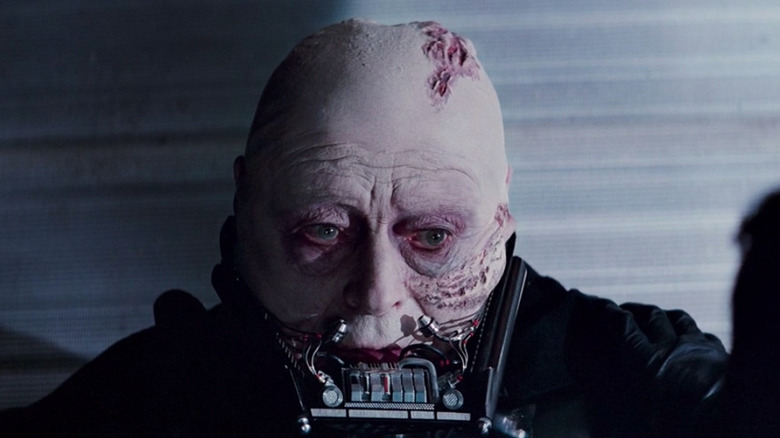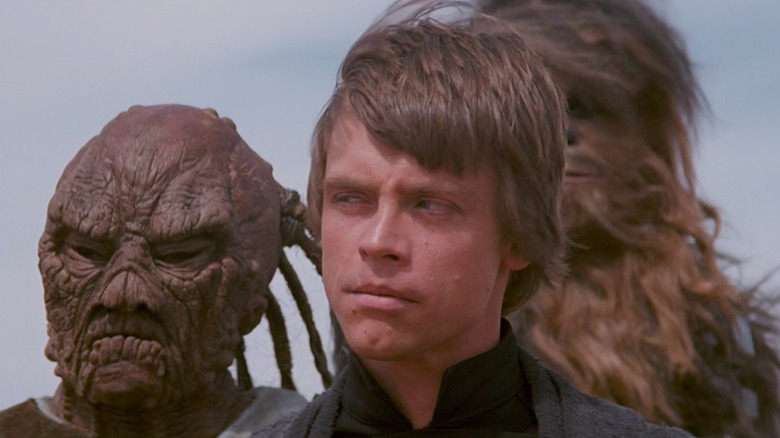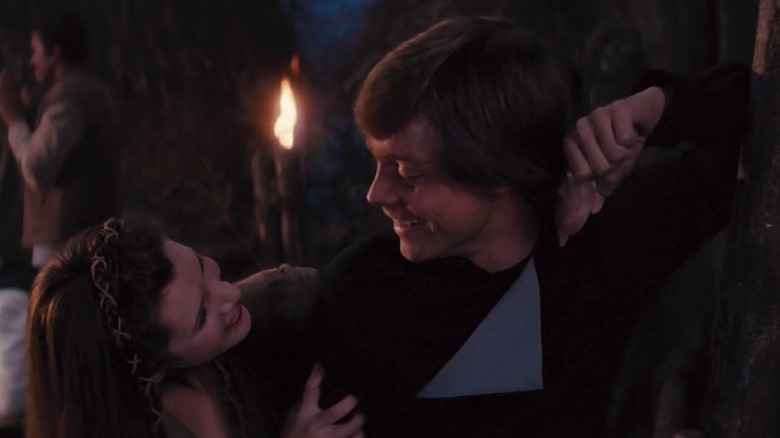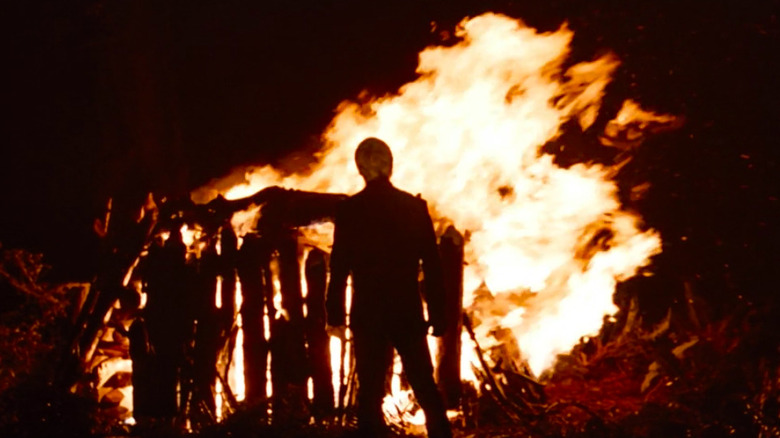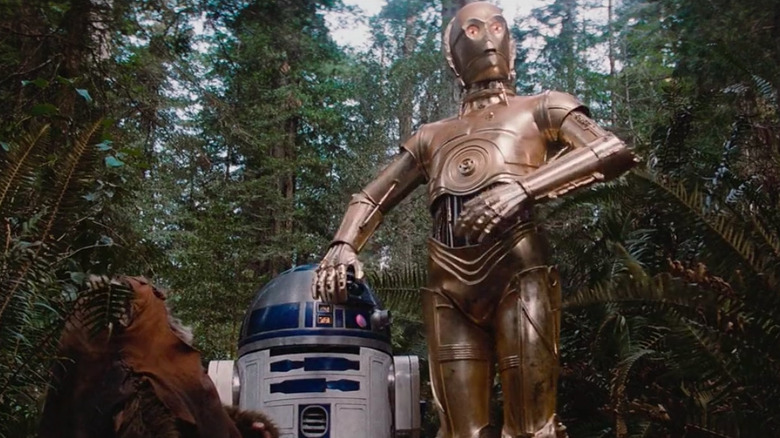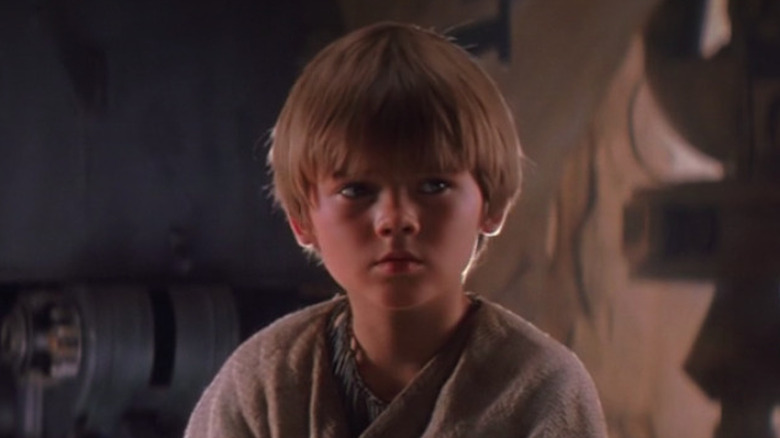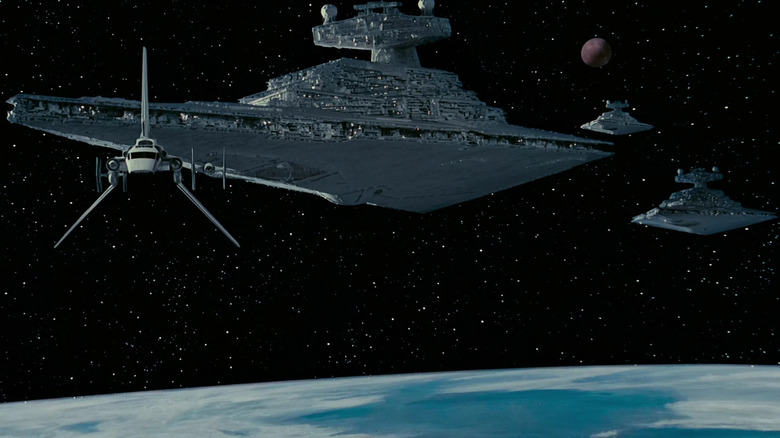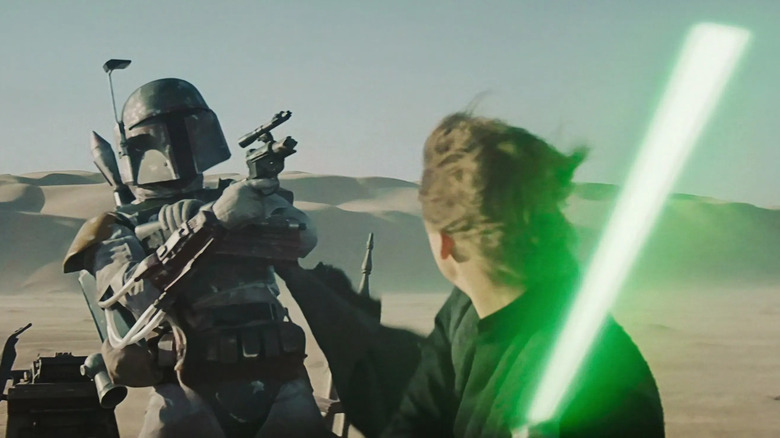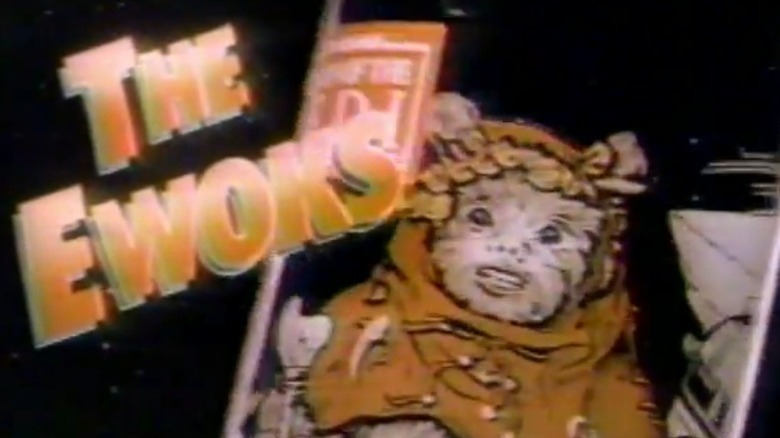What It Was Really Like To See Return Of The Jedi In 1983
If you love "Star Wars," you probably have a definitive personal ranking of all nine episodic movies, modified when including spin-off films and modified again when including television series and/or animated adventures. You know where 1983's "Return of the Jedi" fits within that list for you. You know the lore of the characters, the timeline of the story. but are you old enough to remember what it felt like to see the film when it first debuted?
Maybe "Return of the Jedi" has been part of your childhood for so long that you don't even remember a time when it wasn't there. Perhaps you're a newer "Star Wars" fan and you've never explored the genesis of this film as its own without the context of the nearly 40 years' worth of "Star Wars" content that has since been produced. Or maybe you do remember this historic moment in film history and want to take a trip down memory lane. In any case, here's what it was really like to see "Return of the Jedi" in 1983.
(Warning: spoilers for any and all "Star Wars" movies follow.)
'For young people, by young people'
The original "Star Wars" trilogy came at a time in film history when studios were foregoing their traditional business model and looking towards young directors. "Star Wars" creator George Lucas elaborates on this idea in the 2004 documentary "Empire of Dreams: The Story of the Star Wars Trilogy." Corporation-led, marketing-savvy movie studios "realized there was a market for films by young people, for young people because the young person was becoming a bigger part of their market," Lucas explains. New directors were hired out of film school as a means to bring a freshness to the Hollywood landscape as the industry reinvented itself.
While George Lucas didn't direct "Return of the Jedi" (that responsibility fell to Richard Marquand), he did co-write the screenplay and was involved in its production every step of the way. "Return of the Jedi" being the third "Star Wars" movie released meant that Lucas wasn't new to Hollywood anymore, but the film's arrival did bring a sense of reflection upon the influence that an artist like Lucas had on the industry. When he started "Star Wars," he was a fresh young director. The fact that something from his brain made such an impressive cultural impact was a testament to the movie studios' instincts to shift gears and turn their attention toward new directors all those years ago ... and perhaps inspire the youth of the '80s to do the same.
Anticipation was high among the massive fanbase
Some movie series open to mediocre reception and find their legacy years later as cult classics. That was not the case with "Star Wars." The first two films had become cultural phenomena and audiences eagerly awaited "Return of the Jedi," the third installment. Think back to the excitement in the air on opening night of "Spider-Man: No Way Home," another threequel, or even "The Rise of Skywalker," the third of the "Star Wars" sequel trilogy films. This isn't a new thing. Audiences in 1983 did the same thing we do in 2022: totally geek out at the movies.
Long before electronic seat reservations were standard (or even fathomable), fans in Los Angeles waited outside their theater for six days prior to the midnight debut of "Return of the Jedi" on May 25, 1983, and why wouldn't they? After all, the previous film "The Empire Strikes Back" had left everyone with the cliffhanger that Darth Vader was Luke's father. What would follow THAT revelation? In 1983, the Denver Post claimed that "Return of the Jedi" was "one of the most anticipated movies of all time," sharing a photo of moviegoers waiting outside in costume as their favorite characters. Adoration for this galaxy far, far away has truly been bringing people together for generations.
The movie kept changing names
There's a lot of pressure on the name of a movie. It has to embody what the movie is about, both literally and thematically, while also serving as a marketing device of sorts to entice audiences to see it. That being said, if the working title just doesn't fit, a change is in order.
"Return of the Jedi" was originally titled "Revenge of the Jedi." It wasn't just an internal, temporary name that was changed before announcing the movie to the public, either. It made it so far that the first trailer for the movie advertising "Revenge of the Jedi" to prospective audiences! Eventually, "Revenge" was swapped for "Return." (Footage from the movie's opening night shows in-the-know fans wearing shirts bearing the original "Revenge" title.) A good idea never really goes away, though, because in 2005 the removed word would finally make its way into a "Star Wars" movie with the release of "Star Wars: Episode III – Revenge of the Sith."
The release date was nostalgic for longtime fans
"Return of the Jedi" debuted in theaters on May 25, 1983, exactly six years to the day after "Star Wars" debuted in 1977. A lot had happened in six years, and the finale of the trilogy debuting on the exact same day as the film that started it all was fitting. There's something about the cycle of the calendar that prompts reflection. The consistency of cyclical seasons or holidays are natural times to remember where we were in years prior.
"Star Wars" and "Return of the Jedi" serving as bookends of a trilogy, released on the same day of the year, would've felt familiar and cathartic to those who had been with the series since the beginning. As fate would have it, the Disney+ series "Obi-Wan Kenobi" sought to strike a similar nostalgic chord, setting its release date for May 27, 2022.
It was a relief to see Harrison Ford
Think it was a given that everyone from the previous "Star Wars" movies would want to come back for the third? Think again. Han Solo actor Harrison Ford was only signed on for two "Star Wars" films initially. The documentary "Empire of Dreams: The Story of the Star Wars Trilogy" reveals that Ford thought his character's story didn't really have anywhere else to go and suggested Han be killed off.
That sentiment seems all but blasphemous when considered in retrospect, especially when thinking about the comeback Han would have in 2015's "Star Wars: The Force Awakens," which wouldn't have been possible if Han was already dead. Even when only thinking of "Return of the Jedi" and nothing else beyond it, the cast would have simply felt incomplete without Ford's dynamic presence. There was also the matter of Ford moving on to focus on the "Indiana Jones" films, which had become a success in their own right. All's well that ends well for "Star Wars" casting, because Ford eventually agreed to participate in the third film. Thank the maker!
Jabba the Hutt was one creepy dude
Jabba the Hutt had been mentioned in "Star Wars" and "The Empire Strikes Back" as someone that various characters owed money or otherwise were in messy business arrangements with. Despite being talked about, though, Jabba never actually appeared on screen until 1983's "Return of the Jedi." (He was retroactively added to 1977's "A New Hope" for the 1997 re-release.)
No matter what Jabba looked like, his image would have been a fun reveal in contrast to what audiences had imagined in their heads during the prior two movies. Huge, imposing, and altogether menacing, the filmmakers delivered on Jabba's reputation. As for film critics? They had their work cut out for them. How does one describe Jabba the Hutt to someone who hasn't seen the movie yet? Critic Roger Ebert called Jabba "a cross between a toad and the Cheshire Cat." The Hollywood Reporter said he was "truly frightening" and "gross." The British Film Institute wrote poetry in saying Jabba was "imposingly repellant" of "nightmarish complacency."
This movie was a special effects tour-de-force
Any movie in the sci-fi genre has to rely on a great deal of movie magic to pull off the illusion of actually being in space. Whether a film achieves this effort or embarrasses itself is dependent on the effectiveness of its special effects.
In its 1983 review of "Return of the Jedi," the Boston Globe shared that the movie had double the number of special effects as the original "Star Wars" and took over three times as much money to produce. Chase sequences through the forest moon of Endor, battles outside and within a giant space station, and everything in between made "Return of the Jedi" a fantastic spectacle to 1983 viewers. It grabbed the attention of the Academy of Motion Picture Arts and Sciences, who awarded "Return of the Jedi" a Special Achievement Oscar in 1984 for visual effects. This was before there was a separate category for best visual effects like there is today.
The Ewoks were divisive
There are, shall we say, polarizing creative choices within the "Star Wars" universe that fans have different perspectives on. While today, it's easy to look back on films that are considered classics and assume that nothing was controversial at the time of their release, "Return of the Jedi" actually put fans at odds when it came to a new creature the film introduced: Ewoks.
The cuddly-looking, bear-like animals on the moon of Endor turn out to be quite the battle soldiers when faced with threats. In 1983, audiences were divided on what they thought of Ewoks and how they welcomed them (or didn't) into the series. Some audience members criticized the Ewoks as being nothing but a marketing device to sell toys. The subject, it seems, was something of a hot topic among fans in the '80s. (Good thing we've moved on past those kinds of petty squabbles about things that we claim ruin "Star Wars," right?) Love them or hate them, the Ewoks went on to star in their own made-for-TV movies and animated TV series.
Spoilers were already a thing in 1983
We've all been there. You innocently log into Twitter around 8am and there are already posts about the new episode of "The Mandalorian" that dropped in the middle of the night. Or maybe a headline unashamedly gives away the end credits scene of "Eternals." Do you get mad when someone spoils a movie or television show before you've gotten the chance to see it? Dodging spoilers is an art, but it's not a new practice. While 1983 audiences may not have been avoiding tweets, they had means of their own to be wary of when "Return of the Jedi" debuted.
In footage from a 1983 newscast recorded seemingly on opening night, an audience member spills that Darth Vader "unveils himself" to Luke. Save a brief glimpse at the back of his head in "Empire," Darth Vader had very much been masked and cloaked, with no intention or even mention of ever taking off his signature attire. News that he appears in "Return of the Jedi" in some sort of visually revealing way would have been a major spoiler. Elsewhere in the same set of interviews, another audience member reveals that the movie ends in celebration. While this perhaps could have been predicted for those who knew the movie was the finale to a trilogy, even a happy ending wasn't necessarily guaranteed and still would have at least been a minor spoiler. Watch out, viewers of the nightly news!
Would a new studio regime ruin Jedi?
Movie fans know that the story shown on screen in any film only scratches the surface. Hollywood history is filled with backstage sagas of alternate versions of movies that changed as production progressed, themes or sequences that were removed prior to the final cut, or even entire films that never saw the light of day. Sometimes this folklore stems from creative differences, while other times it's the work of an executive pulling the ear of the director, and it usually doesn't end well when that's the case.
Alan Ladd, Jr. led 20th Century Studios during the first two "Star Wars" films and supported George Lucas tremendously, as shared in the documentary "Empire of Dreams: The Story of the Star Wars Trilogy." He departed the studio in 1980, and any fan in the loop on industry news would have been concerned as "Return of the Jedi" began its development. Would whoever replaced Ladd have equal support of Lucas's vision? Would they want to interfere to push an agenda, or meddle with creative decisions they didn't understand? We're just imagining the subreddits that could have existed in 1983! Thankfully, "Return of the Jedi" plowed forward as planned and as visioned despite the shake-up of leadership.
Return of the Jedi made box-office history
Perhaps unsurprisingly given the extreme popularity for all things "Star Wars" from the series' inception in 1977, "Return of the Jedi" did wonders at the box office and made history. The New York Times excitedly broke the news a few days later that the movie's opening day, May 25, 1983, earned $6.2 million, the biggest opening day in movie history at that time. It beat the previous record held by 1982's "Star Trek II: The Wrath of Khan." Despite the phenomenon that "Star Wars" clearly was, the Times noted the success of "Return of the Jedi" was furthermore impressive because its release day was a Wednesday rather than the traditional Friday opening. Even on a weeknight, nothing was going to keep audiences away from seeing what happened next for Luke Skywalker.
In keeping with tradition, future "Star Wars" films would achieve this same feat. When perusing Box Office Mojo's list of biggest opening day box offices, we can see other movies in the series after "Return of the Jedi" to break the opening day record at the time of their respective releases, including 1999's "The Phantom Menace," 2005's "Revenge of the Sith," and 2015's "The Force Awakens."
This was the end of an era
"Return of the Jedi" was the third and final film in the original "Star Wars" trilogy, and as such had an intentional feeling of closure to it. There was no jaw-dropping cliffhanger. All the characters' stories were wrapped up, and 1983 audiences witnessed a three-part story come to an end. Mark Hamill reflects in the documentary "Empire of Dreams: The Story of the Star Wars Trilogy" about the completion (at the time) of his formative Luke Skywalker role. "We really had the sense that it was the end," Hamill says. "There was a kind of 'clearing your locker out at the end of the semester' feel to it all. So part of me was saying, 'Oh, I'm so glad to put this behind me.' And the other aspect was, 'Well, what about all the adventures that Luke could have?'"
While that wouldn't end up being the last time Mark Hamill brought Luke Skywalker to life, there was no way of knowing that in 1983. For all intents and purposes, "Return of the Jedi" was the finale for the three-arc story that propelled "Star Wars" into something that changed the entertainment industry forever.
Was this a satisfying ending? The jury was out
It can be difficult to please everyone when it comes to sequels, especially if it's the last entry in a series. The audience comes into the story with preconceived expectations of what they think should happen to the characters or how the narrative should conclude. This is natural on the audience's part, especially when one is invested in the world of a story. To have hopes for what might happen next, or how the story will end is part of the experience. However, living up to those expectations is sometimes an impossible task for filmmakers.
Critics in 1983 were contradictory in their reception of "Return of the Jedi." The Hollywood Reporter lamented that the film seemed "woefully familiar" and claimed it had a "kind of desperation about it," positing that the film's writers were "simply trying to figure out what they [could] do next to amuse the kiddies." By contrast, the Washington Post called the film a "triumph" and a "feat of mass enchantment," going on to say it "couldn't end the 'Star Wars' trilogy on a happier note." Everybody has their own take, and if one thing is constant across generations it's a varying level of satisfaction toward the last entry in a "Star Wars" trilogy.
This wasn't the end of Star Wars
It would be easy and even logical to assume that the original trilogy was initially constructed as a one-and-done set of three movies, but that wasn't the case. It was later reshuffled in the "Star Wars" timeline when the prequel trilogy came along. While it's true that "Return of the Jedi" was the final movie in the original "Star Wars" trilogy, there was plenty more yet to come, and audiences knew this. Even in 1983, it was public knowledge that George Lucas intended to make nine "Star Wars" movies and that "Return of the Jedi" was placed as sixth in the story. Quite the ambitious undertaking to reveal to the general public! Nonetheless, it would be 16 years before the story expanded when 1999's "The Phantom Menace" kicked off the prequel trilogy.
While 1983 moviegoers might have known more "Star Wars" was on the way after "Return of the Jedi," they didn't expect Luke, Leia, or Han Solo to ever re-enter the narrative. In his 1983 review, critic Roger Ebert said "Return of the Jedi" would be "the last we'll see" of the trio, but interestingly claimed that "the robots will be present in all the films." The droids would indeed continue to make appearances, but so would the three original leads, even if it took a bit longer.
Jedi was reminiscent of E.T.
In 1983, Ewoks and rancors weren't the only outer-space creatures on moviegoers' minds. Just one year prior, Steven Spielberg's "E.T. the Extra-Terrestrial" had become a huge hit. While "E.T." and "Return of the Jedi" are quite different, audiences might have felt a similar euphoria while viewing both movies.
Starlog Magazine highlighted reader reviews shortly after "Jedi" debuted. Brian Richards from Minnesota wrote to the publication that "Jedi" was "the first film since I saw 'E.T.' that made me feel real good inside. I left the theater with my spirits soaring ... 'Return of the Jedi' is destined to become a classic!"
Other readers weren't always unified in their consensus. Frank Gerard from New Jersey wrote, "'Return of the Jedi' was an overwhelming disappointment. I simply cannot believe George Lucas has given to eager 'Star Wars' fans everywhere a film which belongs on 'The Muppet Show' or Saturday morning TV." Meanwhile, Barb Trimble from Mississippi had a hot take: "This movie is a non-stop ride on that 'Star Wars' rollercoaster. You barely have time to settle back in your seats after a 'white-knuckler' of a scene, then it's off again for round two. Bravo, George!"
It inspired a new generation of filmmakers
"Return of the Jedi" was more than just a movie to some of its viewers. Inspired by its characters, story, and filmmaking technique, some audience members in 1983 left the theater feeling inspired to make movies of their own.
This included Brad Bird, who at the time was 25 years old and working as an animator at Disney. Bird would later direct "The Iron Giant" and "The Incredibles," among other films, and in 1983, "Star Wars" movies charged his creativity. In the foreword of the 2013 edition of the book "The Making of Return of the Jedi," Bird shares that he snuck into a Lucasfilm crew screening of "Return of the Jedi" and marveled at seeing the film in the same room as George Lucas and Richard Marquand. "I was now surrounded by the very geniuses who had brought this rarest of cinematic sagas to a satisfying conclusion in grand style," Bird writes.
However, Bird wasn't wild about everything in the movie, specifically feeling like Luke's character had made an unrealistic leap from the hero-in-training he was at the end of "The Empire Strikes Back" to the confident protagonist he suddenly appeared to be by the beginning of "Return of the Jedi." Bird reflects, "The point is not that I, or any other fan, agree with every single choice George has made in telling his epic saga. The point is that we care."
Burger King sold an exclusive collectible
Naturally, the place where all "Star Wars" fans wanted to go immediately after their screening of "Return of the Jedi" was ... Burger King? It was, if you wanted to get your hands on some new, unknowingly medically dangerous "Jedi" merch. The fast-food hamburger chain sold four collectible glasses, rolled out one week at a time, featuring painted artwork inspired by the movie. This kept tradition with a similar tie-in the restaurant had for "The Empire Strikes Back" in 1980 and even the original "Star Wars" in 1977.
A television commercial advertising the "Jedi" glasses hails, "Thrill with the adventures of Luke Skywalker, the Ewoks, Han Solo, and Jabba the Hutt!" Customers got a discount on the glasses if they also purchased a medium or large Coke. Fans looking to find these collectibles today can still bid for them on places like eBay. Just don't drink out of them. Decades later, some were found to be poisoned with lead.
